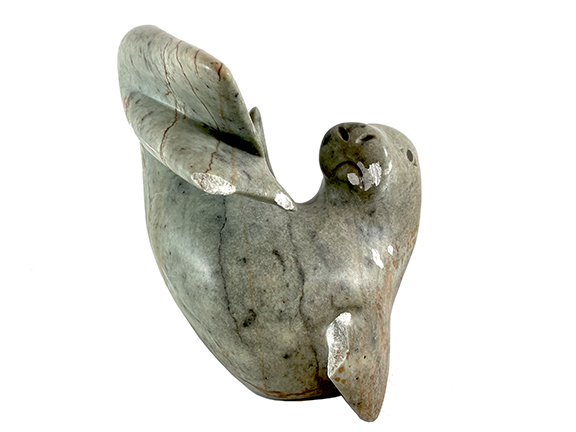
Abraham Anghik, Seal
Abraham Anghik
1951-
Inuit / Inuvialuit
Alternative Name
Abraham Anghik Ruben
Date
1995
Medium Specific
Brazilian soapstone
Classification
Sculpture: Stone
Dimensions
8 1/4 x 8 x 7 1/2 in. (21 x 20.3 x 19.1 cm.)
Accession Number
2023.35.28.19
Credit
Gift of Gloria and Selig Kaplan
Memo / Artist Statement
"I have always tried to learn from others, either Inuit or other elderly people who can pass on their knowledge of what life is about. I try to put that into my sculpture." -- 2001
Biography
Abraham was born in 1951 in a camp south of Paulatuk, Northwest Territories and east of the Mackenzie River Delta. This region is home to the Mackenzie Inuit or Inuvialuit. Abraham’s great-grandparents, noted shamans Apakark and Kagun came from the Bering Sea region of Alaska during this time. By the time of Abraham’s birth, Inuit culture was in the midst of a profound change that would forever alter their traditional way of life and set the stage for Abraham’s lifelong quest to re-discover and connect with his roots.
Up until the age of 8 Abraham lived with his family on the land migrating with the changing patterns of the seasons. In 1955 this existence was to change dramatically for Abraham when Abraham and his other brothers were themselves sent to boarding school. Abraham’s quest to reconnect with his past found artistic form in 1971 when he attended the Native Arts Centre at the University of Alaska studying under Ronald Senungetuk. Throughout the 1970s Abraham pursued a career as an artist working in the varied media of sculpture, jewelry, prints and drawings. He would soon catch the attention of art dealers across Canada including Jack Pollock who showed his sculptures at his gallery in Toronto in a series of solo exhibitions.
In 1986 Abraham moved to Salt Spring Island where he continues to live and work with his wife Patricia Donnelly and their children. Since that time, Abraham’s interests in exploring the stories, myths and legends of his ancestors have found artistic form in a multitude of works, which have been exhibited and collected internationally. In late 2004, while recovering from an ordeal with cancer, Abraham gained a new perspective on life that enabled his artistic practice to reach a new high. http://www.abrahamruben.com/biography/
Up until the age of 8 Abraham lived with his family on the land migrating with the changing patterns of the seasons. In 1955 this existence was to change dramatically for Abraham when Abraham and his other brothers were themselves sent to boarding school. Abraham’s quest to reconnect with his past found artistic form in 1971 when he attended the Native Arts Centre at the University of Alaska studying under Ronald Senungetuk. Throughout the 1970s Abraham pursued a career as an artist working in the varied media of sculpture, jewelry, prints and drawings. He would soon catch the attention of art dealers across Canada including Jack Pollock who showed his sculptures at his gallery in Toronto in a series of solo exhibitions.
In 1986 Abraham moved to Salt Spring Island where he continues to live and work with his wife Patricia Donnelly and their children. Since that time, Abraham’s interests in exploring the stories, myths and legends of his ancestors have found artistic form in a multitude of works, which have been exhibited and collected internationally. In late 2004, while recovering from an ordeal with cancer, Abraham gained a new perspective on life that enabled his artistic practice to reach a new high. http://www.abrahamruben.com/biography/
Date of Bio
Inscription
Anghik '95
